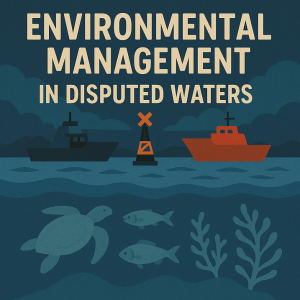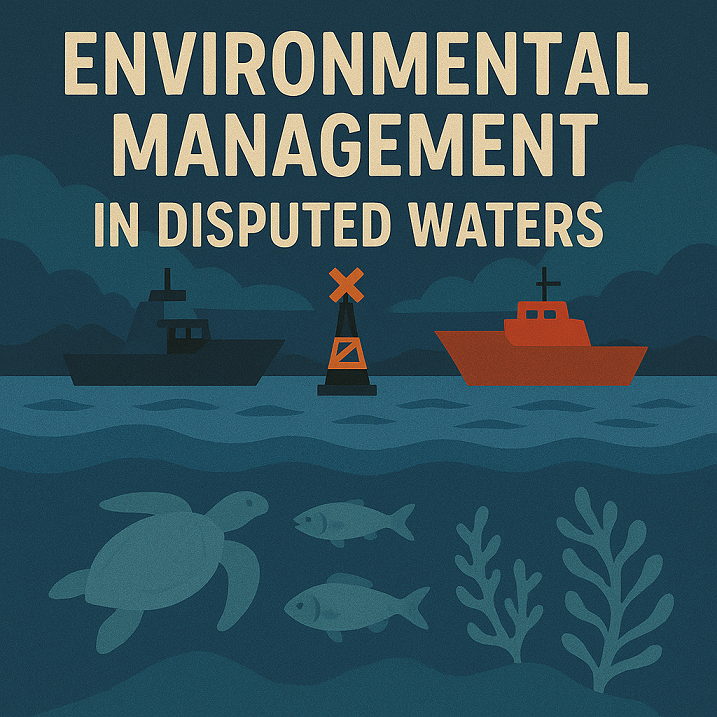Learn how transboundary environmental management in the disputed waters of the South China Sea is becoming essential to preserving marine biodiversity, preventing resource collapse, and easing regional tensions. This comprehensive guide explores key developments, challenges, and cooperative frameworks.

Why Transboundary Environmental Management Matters in the South China Sea
The South China Sea, rich in marine biodiversity and natural resources, is not only one of the most geopolitically sensitive bodies of water in the world—it’s also one of the most ecologically vulnerable. It covers over 3.5 million square kilometers and is bordered by China, the Philippines, Vietnam, Malaysia, Brunei, and Taiwan. Yet overlapping territorial claims have complicated efforts to manage shared marine environments.
Environmental degradation here doesn’t stop at borders. Currents carry pollutants across zones, coral bleaching affects interconnected reefs, and migratory fish pay no heed to exclusive economic zones (EEZs). As such, transboundary environmental management—the joint stewardship of shared marine resources across political lines—has become more than an ecological ideal. It is a regional necessity.
The International Maritime Organization (IMO), UN Convention on the Law of the Sea (UNCLOS), and ASEAN frameworks support environmental cooperation, but enforcement is often fragmented. As marine biodiversity continues to decline, cross-border ecological diplomacy may be one of the few remaining bridges to peace and sustainable development.
A Sea Under Siege: Key Environmental Pressures
Marine Pollution and Plastics
The South China Sea is plagued by land-based and marine-based pollution. Rivers such as the Mekong, Pearl, and Red River discharge millions of tonnes of plastic annually. According to the World Bank (2023), three of the top ten plastic polluters globally are located in the region.
Industrial runoff, ship-generated waste, and untreated sewage further compromise water quality. Coral reefs suffer, fish populations decline, and human health risks rise in coastal communities.
Coral Reef Destruction
Over 30% of the South China Sea’s coral reefs have been degraded, many irreversibly. The Journal of Marine Science and Engineering (2022) notes that destructive fishing, dredging, and land reclamation have altered habitats. Artificial island construction by several claimant states has buried reefs under tonnes of sand and concrete.
Overfishing and IUU Activities
Illegal, unreported, and unregulated (IUU) fishing remains widespread. The FAO and Global Fishing Watch confirm that much of the sea experiences near-constant fishing pressure. Fish stocks like mackerel, anchovy, and grouper are nearing collapse.
Transboundary management is essential because fishing vessels from different nations frequently operate in contested waters, leading to not only environmental harm but also geopolitical flare-ups.
Climate Change
According to the IPCC Sixth Assessment Report, the region is experiencing rising sea temperatures, ocean acidification, and extreme weather events. These trends accelerate coral bleaching and coastal erosion, threaten low-lying islands, and destabilize fisheries.
Frameworks and Agreements: What Exists So Far?
UNCLOS and Regional Cooperation
While UNCLOS provides the foundation for maritime rights and responsibilities, its application in the South China Sea is contested. Article 123 encourages cooperation in enclosed or semi-enclosed seas, yet there is no binding multilateral mechanism exclusive to this region.
ASEAN Efforts
The ASEAN Declaration on the Protection of the Marine Environment (2017) outlines cooperative measures, yet it lacks enforceability. Similarly, the ASEAN-China Code of Conduct—under negotiation for over two decades—remains non-binding.
FAO Port State Measures Agreement
Some regional countries are parties to this agreement, which helps prevent IUU fishing by controlling port access for non-compliant vessels. However, effectiveness is undermined by varying levels of implementation and monitoring capacity.
Bilateral and Track II Dialogues
Informal platforms such as the South China Sea Workshops and Track II diplomacy led by regional think tanks have enabled scientist-to-scientist collaboration. Notably, Vietnam and the Philippines have held academic-level joint marine biodiversity surveys, showing the power of dialogue beyond politics.
Emerging Tools and Technologies for Transboundary Management
Satellite Surveillance and Remote Sensing
Organizations such as MarineTraffic, Global Fishing Watch, and Lloyd’s List Intelligence offer near-real-time vessel monitoring. This helps identify illegal activities, map ecological hotspots, and enforce conservation zones—even in disputed waters.
China, Vietnam, and the Philippines have used satellite imagery to monitor sediment flows, oil spills, and temperature anomalies. Still, data-sharing remains a hurdle due to mistrust.
Ecosystem-Based Management (EBM)
EBM recognizes the ecological interconnectedness of marine systems. It advocates for managing human activity in the context of entire ecosystems rather than isolated jurisdictions. The Royal Institution of Naval Architects (RINA) and WMU Journal of Maritime Affairs have both endorsed EBM in regional policy design.
Marine Protected Areas (MPAs) and No-Take Zones
Establishing transboundary MPAs could serve as a confidence-building measure. For example, the concept of a Joint Marine Peace Park in the Spratly Islands has been proposed by researchers at the University of the Philippines Marine Science Institute. Although not yet realized, it has backing from civil society and international NGOs.
Case Studies of Cooperation and Conflict
Case 1: Joint Marine Survey in the Gulf of Thailand
Vietnam and Thailand, despite overlapping EEZ claims, conducted a joint hydrographic and environmental survey in 2018. Supported by UNDP and GEBCO, the effort mapped benthic habitats and established a shared marine data portal. Though limited in scope, it proved that even countries with complex histories can find environmental common ground.
Case 2: Scarborough Shoal Tensions
In contrast, Scarborough Shoal—a rich fishing area claimed by both China and the Philippines—remains a flashpoint. After the 2016 Permanent Court of Arbitration ruling, Filipino access was intermittently restored, but environmental monitoring remains politically fraught. A 2023 Greenpeace report revealed evidence of coral damage and unauthorized dredging by foreign vessels.
Obstacles to Effective Transboundary Environmental Governance
Political Sensitivities and Sovereignty
At the heart of many disputes is sovereignty. Countries are reluctant to cooperate on environmental matters if they feel it could undermine their territorial claims. This leads to a stalemate of silence, where ecological degradation continues while diplomacy stalls.
Enforcement Asymmetries
Countries have vastly different capabilities in monitoring and enforcing environmental regulations. While China deploys coast guards and paramilitary fleets, smaller nations like Brunei or the Philippines rely on underfunded maritime agencies.
Lack of Trust and Data Sharing
Even when scientific data is collected, it is rarely shared due to security concerns. This hampers collaborative modeling of ecosystem changes, disaster response, and joint conservation planning.
Fragmented Legal Frameworks
There is no Regional Fisheries Management Organization (RFMO) specific to the South China Sea. Without it, quota management, stock assessments, and joint monitoring remain uncoordinated.
Future Outlook: Building a Blueprint for Shared Stewardship
Establishing a South China Sea Environmental Management Framework
Maritime experts from BIMCO, IMO, and ICS suggest a multilateral platform combining environmental science with cooperative diplomacy. Such a framework could focus on:
- Standardized monitoring protocols
- Shared environmental baselines
- Emergency response coordination (e.g., oil spills)
Blue Diplomacy
The idea of “Blue Diplomacy”—championed by The Nautical Institute—combines ocean governance with conflict resolution. It treats shared seas as platforms for collaboration rather than confrontation.
Financing from Global Funds
Environmental efforts need funding. Mechanisms like the Global Environment Facility (GEF) or Green Climate Fund can support MPAs, capacity building, and pollution control. A South China Sea Environmental Trust Fund, proposed by the World Bank, could facilitate long-term cooperation.
Involving Coastal Communities
Community-led monitoring, ecotourism, and local conservation can empower stakeholders who depend most on healthy marine ecosystems. The Community-Based Coastal Resource Management (CBCRM) model in the Philippines has seen local fish biomass increase by up to 40% in 5 years, according to Marine Pollution Bulletin (2022).
Frequently Asked Questions (FAQ)
Why is transboundary management necessary in disputed waters?
Because environmental degradation doesn’t respect national borders. Fish, pollutants, and currents flow freely across political lines.
Is environmental cooperation possible amid political tensions?
Yes. History shows that scientific cooperation can be a low-risk entry point for broader dialogue.
Who are the key players in environmental governance in the South China Sea?
IMO, ASEAN, FAO, UN, and national maritime agencies. Think tanks, academic institutions, and NGOs also play vital roles.
Can technology really help protect disputed marine areas?
Yes. Tools like satellite monitoring and AIS tracking are already identifying hotspots of illegal fishing and pollution.
What are the risks of inaction?
Fisheries collapse, habitat loss, food insecurity, and heightened geopolitical tensions.
Are there successful models elsewhere in the world?
Yes. The Mediterranean Action Plan and the Baltic Sea’s HELCOM framework show that regional seas can be co-managed across borders.
Conclusion
Transboundary environmental management in the South China Sea is not a luxury—it is a shared survival strategy. As marine ecosystems teeter on the edge, and political tensions simmer, environmental cooperation may offer the only neutral, mutually beneficial path forward. While there is no one-size-fits-all solution, the region’s future may well depend on its willingness to put shared ecology above disputed sovereignty.
From coral reefs to fishing grounds, what is at stake transcends lines on a map. It is about sustaining life, livelihoods, and peace in one of the world’s most critical maritime spaces.
References
- IMO. (2024). Marine Environment Protection. https://www.imo.org/en/OurWork/Environment/Pages/Default.aspx
- UNCTAD. (2023). Blue Economy and Maritime Transport. https://unctad.org/topic/transport-and-trade-logistics/blue-economy
- FAO. (2023). Illegal, Unreported and Unregulated (IUU) Fishing. https://www.fao.org/iuu-fishing/en/
- World Bank. (2023). Plastic Waste in Southeast Asia. https://www.worldbank.org/en/news/infographic/2023/06/05/plastic-pollution-in-southeast-asia
- Marine Pollution Bulletin. (2022). CBCRM Success in the Philippines. https://www.sciencedirect.com/journal/marine-pollution-bulletin
- Global Fishing Watch. https://globalfishingwatch.org/
- WMU Journal of Maritime Affairs. https://link.springer.com/journal/13437
- MarineTraffic. https://www.marinetraffic.com
- Greenpeace Southeast Asia. (2023). Scarborough Shoal Environmental Damage. https://www.greenpeace.org/southeastasia/publication/Scarborough-shoal-report

